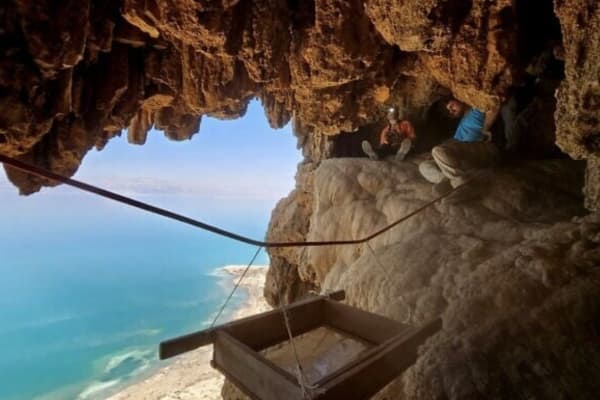Archaeologists excavating the cave where an Aramaic inscription and four Roman swords were discovered in the Judean Desert, with a view of the Dead Sea. (Photo: Oriya Amichai/Israel Antiquities Authority)
An ancient inscription in Aramaic has been found in a cave near the Dead Sea, including four lines of text dating back some 1,900 years, which have fascinated experts as they worked to decipher its meaning.
The inscription is thought to have been penned by Jewish rebels during the 2nd-century Bar Kokhba Revolt against the Romans.
On Monday, Dr. Asaf Gayer of the Department of Land of Israel Studies and Archaeology at Ariel University, and Prof. Jonathan Ben-Dov of the Department of Biblical Studies at Tel Aviv University, presented the discovery and their research at the 19th World Congress of Jewish Studies at The Hebrew University.
Written in the Aramaic language with square Hebrew script – as was common after the Babylonian exile – the inscription covers an area of about 8 x 3.5 cm (3.2 x 1.4 in) on the lower part of a stalactite.
The first line reads, “Abba of Naburya has perished,” but the rest of the inscription has proved difficult to make out. The words “on us,” “he took,” and “the” have been successfully deciphered, but the meaning of the other three lines has been quite a mystery.
“This inscription is extremely rare,” Gayer told the Times of Israel. “Written material from this period is, in general, very rare. Of course, there are the Dead Sea Scrolls, but other than that, most of the inscriptions we have amount to a single name or word. We have only one additional site in the Judean Desert with some graffiti where we can actually read some content. An inscription of four lines with content is almost unheard of.”
The team had planned to capture images of the stalactite with multispectral photography in order to facilitate the deciphering of the last three lines of text.
The inscription was found in a cave that is now well known to archaeologists. Located in the Ein Gedi National Park in the Judean Desert, the cave also contains a stalactite with a much older fragmentary ink inscription in ancient Hebrew, in a script characteristic of the First Temple period, saying , “Blessed is God (Adonai) / Blessed XXX / Blessed is God (Elohim).” Gayer was also involved in efforts to decode that text and identify more of the Hebrew letters from the inscription found back in the 1970s, and dating back to the 7th century B.C.
“The First Temple period inscription had been photographed in the 1970s, and we believed that with more advanced technology, we could get better results,” said Gayer. “By chance, we discovered the second inscription. It was a great surprise for all of us.”
When the team of archaeologists – including Gayer, Ben-Dov, and geologist Boaz Langford of the Institute of Earth Sciences, the Israeli Cave Research Center, and The Hebrew University of Jerusalem – returned to the cave in spring 2023 to reexamine the inscription, they were joined by Israel Antiquities Authority photographer Shai Halevi. During the visit, they came across another major discovery – four Roman swords in nearly perfect condition.
“When one goes into a cave, there’s always a feeling that you’re going to find something,” Gayer told reporters shortly afterwards.
Some more ancient scroll fragments have been found in the area around the cave, also thought to have been hidden away in the time of the Jewish revolt led by Bar Kokhba in 132-135 A.D. The swords may have been left in the cave during that same period.
According to Gayer, the fact that the inscription was found in such close proximity to the swords and a Bar Kokhba coin would suggest the inscription also dates back to the same period. “However, we cannot be certain,” he cautioned. The use of Aramaic and the shape of the lettering also provide clues to the archaeologists as they work to accurately date their discoveries.
“Paleographers can recognize the script typical of the 3rd century C.E. or the 1st century C.E.,” Gayer explained. “In our case, the language and style point to the 1st or 2nd century C.E.,” he added. “However, because the inscription is so small and not well preserved, we can’t tell whether it dates to the First Jewish Revolt in 70 CE, the period between the two uprisings, or the Bar Kokhba Revolt.”
“It appears the writer aimed for a high-quality inscription but did not succeed,” Gayer said. “This may have been due to the difficulty of writing on the stalactite’s surface in such small letters, or because they lacked formal training. The result is a mixture of semi-formal script and cursive characters.”
Judeans gradually abandoned the ancient Hebrew script in favor of a newer square script by the 3rd century B.C., by which time Aramaic had become the lingua franca commonly used by everyone. “That same square script is the one we still use for Hebrew today,” Gaya explained.
The team has made progress on dating the inscription, but understanding what it means has proved much harder. Ancient Jewish literature shows that the name Abba was commonly used at the time, and Naburya village near Safed is mentioned in the Jerusalem Talmud, (Tractate Yevamot 2:6), but other than that, information about Abba of Naburya and his story remains elusive.
Undeterred, Gayer’s team continues to search for more treasures and clues with the use of multispectral photography and other advanced techniques. “Every new letter found matters,” he enthused. “There is great potential for new discoveries.”
Gayer and the team are working towards the publication of a peer-reviewed academic article about the historical inscription.
Dr. Asaf Gayer, of the Department of Land of Israel Studies and Archaeology at Ariel University, at the site of the cave near Ein Gedi, where he discovered an ancient Aramaic inscription and four 1,900-year-old Roman swords. (Photo: Israel Antiquities Authority)
Is ALL ISRAEL NEWS’ faithful reporting important to you? Be part of it—help us continue by becoming a $5/month supporting partner .




